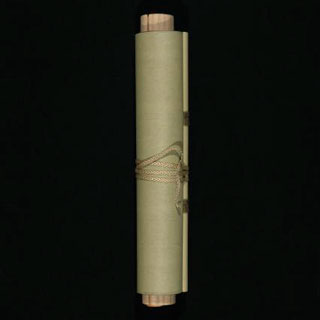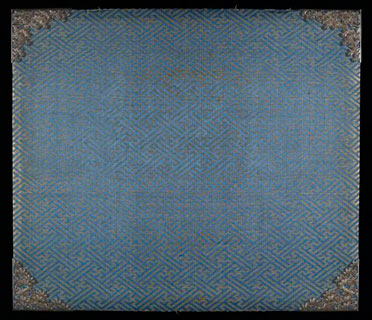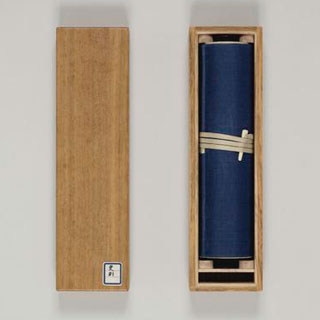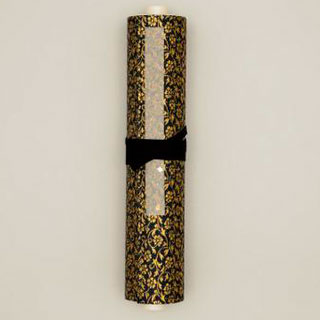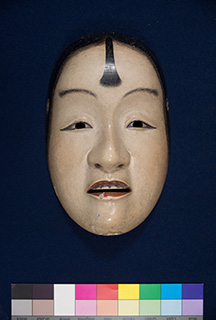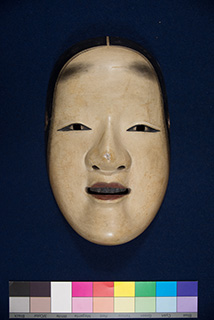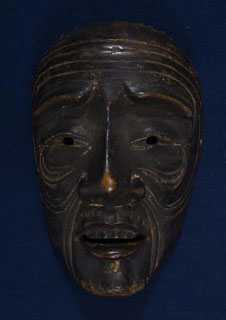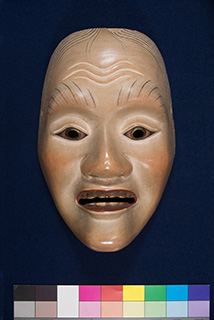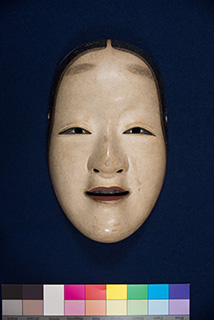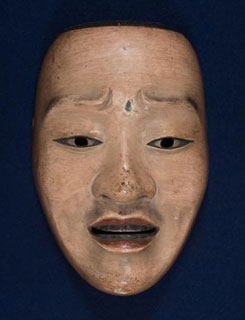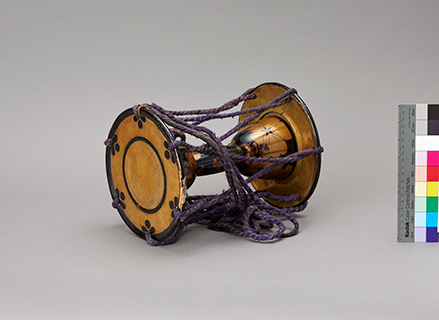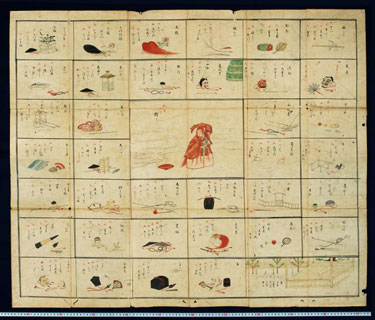Art
The first and foremost intersection of nō and kyōgen with art is in tools and stage
properties used in performances, namely masks, costumes, and musical
instruments. In addition to their aesthetic value, props are of historical
importance, as they were carefully preserved or copied for centuries. Although
not included in this category, book design, as in the case of Kōetsu utaibon,
is also worth considering as an art in itself. When works were commissioned by political
authorities like daimyō (provincial warlords), the works could be
exemplars of exhibitions of power and commitment to the theatrical genre.
Artisans have also created works that are not directly related to stage performance. In
the Edo period (1603-1867), a number of painters, ranging from those belonging
to privileged schools like the Kanō or Tosa to those of unknown lineage,
painted scenes of excerpts from plays, resulting in a genre called nō-e
(nō painting). Some paintings portray how and in what environment the
performance was held rather than the staging itself. Works of art inspired by
nō and kyōgen, such as board games using the symbols and motifs derived from
plays, also exist. These works gesture to the cultural esteem of nō and kyōgen.
-
- Title:
- Portrait of Miyamasu Yazaemon Chikakata
- Title (jp):
- Miyamasu Yazaemon Chikakata gazō 宮増弥左衛門親賢画像
- Description:
- Hanging scroll, ink on paper. Image dimension: 59.5 x 25.5 cm. The portrait of the shoulder drum player Miyamasu Yazaemon Chikakata (1482-1556) is the oldest among the extant portraits of nō performers. The painter is Kubota Muneyasu, a yamato-e painter active in Kyoto and Wakasa, who also practiced nō as an amateur. Inscription is by Eiho Eiyū (1547-1602), a Zen monk of the Rinzai school.
- Collection name:
- Kanze Shinkurō Family Collection
- Volume:
- 1
-
- Title:
- Folding Albums of Nō
- Title (jp):
- Nō on-ekagami 能御絵鑑
- Description:
- Folding album, two volumes. Ink on paper, image dimension 30 x 36 cm. The albums portray a total of 150 scenes from each nō play. Each painting’s minute detail in masks, costumes, and stage props reflects the actual staging. The painter is Kanō Shunko (d. 1726) who served the Edo shogunate, according to the colophon. Since the plays chosen in these albums match the Kita school’s repertoire, it is assumed that the albums were commissioned by someone related to the sixth shogun Tokugawa Ienobu (1662-1712) and presented to the Konoe family, the family of Ienobu’s wife. The National Noh Theatre and Uwajima Date bunka hozonkai (Date Family Culture Preservation Society in Uwajima) have folding albums of similar design.
- Collection name:
- Noh Theatre Research Institute
- Volume:
- 2
- View all
-
- Title:
- An Overview of Nō and Kyōgen Performance
- Title (jp):
- Sarugaku zuryaku 猿楽図略
- Description:
- Handscroll, paper height 22.7 cm. The scroll was originally a book of fukurotoji binding but was dissembled and glued together as a scroll later. This color-illustrated scroll portrays the nō performance held in Nagoya in the tenth month of 1836 (Tenpō 7). Together with illustrations of stage performance, a summary of each day and a poem related to the performed nō or kyōgen plays are written within the frame. A full record of the programs is added at the end of the scroll. Written and illustrated by Shungetsutei Baikō, with an epilogue by Odagiri Shunkō (1810-1888), a painter in Nagoya.
- Collection name:
- Hosei University Kōzan Collection
- Volume:
- 1
-
- Title:
- Picture Scroll of Kōka Kanjin Nō
- Title (jp):
- Kōka kanjinnō emaki 弘化勧進能絵巻 一・二
- Description:
- Handscroll, two volumes, rod length 27.0 cm. This scroll illustrates the 15-day kanjin nō held by the head of the Hōshō troupe in 1842 (Kōka 5). It records every detail of this large-scale event: tickets, the huge venue and surrounding buildings, the backstage area, green rooms, design of the decorations of the stage, notices to the actors, expenses, number of spectators who attended each day, and full programs. The original painter is thought to be Saitō Gesshin (1804-1878), but the original is lost and only copied scrolls remain today at multiple institutions. This version owned by our Institute was copied by Ōkubo Hasetsu (active circa late 19th- early 20th century).
- Collection name:
- Noh Theatre Research Institute
- Volume:
- 2
- View all
-
- Title:
- Nō Mask Kokasshiki
- Title (jp):
- Nōmen Kokassiki 能面 小喝食
- Description:
- Kasshiki refers to chigo (“child acolytes”), who worked as servers of meals at Buddhist temples but also received training in various performing arts, including singing and playing musical instruments. The kasshiki mask indicates the boy’s young age (approximately seven to mid-teens) with his ginkgo leaf-shaped bangs and dimples on his cheeks. This specific mask is named “ko” (“small”) kasshiki because the bangs are relatively small. The mask is used specifically for plays in which a kasshiki is the protagonist, namely Kagetsu, Jinen Koji, and Tōgan Koji.
- Collection name:
- Noh Theatre Research Institute
- Volume:
- 1
-
- Title:
- Nō Mask Magojirō
- Title (jp):
- Nōmen Magojirō 能面 孫次郎
- Description:
- Magojirō is the mask for a relatively young woman. Legend says that the 16th-century actor Kongō Magojirō carved the mask in memory of his late wife and named it “omokage” (“image”), but later this type of mask came to be called by the name of its original carver, Magojirō. Compared to the koomote mask which represents a young maiden, the Magojirō mask has the more humanly facial expression of a slightly mature woman. Magojirō is used for various female plays such as Yuya. This mask was formerly in the collection of the Uesugi family of the Yonezawa domain.
- Collection name:
- Noh Theatre Research Institute
- Volume:
- 1
-
- Title:
- Nō Mask Jō
- Title (jp):
- Nōmen Jō 能面 尉
- Description:
- Jō refers to an old man who, in nō plays, usually embodies a sacred or supernatural quality. Jō masks are further classified according to their facial features and have names such as sankō-jō or ko-jō. However, this particular mask is simply called jō, for its archaic design does not match today’s typical characteristics of elderly men’s masks. The mask’s paint has fallen off and the wooden base is exposed. Its archaic design even suggests that the mask may have been used for sarugaku performance, a genre before nō was perfected into today’s form. According to the recollections of Nogami Toyoichirō, he obtained six masks that originally belonged to a temple in Kamakura, and none of the three jō masks he obtained, including this one, fell into today’s classifications.
- Collection name:
- Noh Theatre Research Institute
- Volume:
- 1
-
- Title:
- Nō Mask Yamanba
- Title (jp):
- Nōmen Yamanba 能面 山姥
- Description:
- The mask Yamanba is used only for the play Yamanba. Yamanba is a hag who is not evil but rather represents the mountains’ mystic and even cosmological power. Gold eyes, grey hair, and sunburnt skin indicate her identity as lying beyond the human.
- Collection name:
- Noh Theatre Research Institute
- Volume:
- 1
-
- Title:
- Nō Mask Zō Onna
- Title (jp):
- Nōmen Zō onna 能面 増女
- Description:
- The “zō” in zō onna comes from the name of the dengaku performer Zōami (fl. 15th century) who is said to have carved this type of female mask. With its firm cheeks and clear-cut facial features, the zō onna mask is used for noble female figures, such as the celestial maiden in Hagoromo or the female deity in Miwa. Formerly in the collection of the Uesugi family of the Yonezawa domain.
- Collection name:
- Noh Theatre Research Institute
- Volume:
- 1
-
- Title:
- Nō Mask Kantan Otoko
- Title (jp):
- Nōmen Kantan otoko 能面 邯鄲男
- Description:
- Kantan otoko is used mainly for the play Kantan. As the protagonist Rosei is first full of worries but later realizes the essence of life after sleeping on the Pillow of Kantan, the mask captures both his distress and enlightenment.
- Collection name:
- Noh Theatre Research Institute
- Volume:
- 1
-
- Title:
- Shoulder Drum with Noble Purple Rope
- Title (jp):
- Kotsuzumi Shichō 小鼓 紫調
- Description:
- Shoulder drums (kotsuzumi) parts are usually assembled with orange rope, but this drum is assembled with purple rope, indicating its noble origin. In the Edo period, the shogun would grant purple-roped drums to shoulder drum players whom he acknowledged as having superb skills. This drum was granted to Kanze Shinkurō Toyoshige by the fifth shogun, Tokugawa Tsunayoshi (1646-1709), on the occasion of a performance held at the Edo Castle in 1678 (Enpō 6).
- Collection name:
- Noh Theatre Research Institute
- Volume:
- 1
-
- Title:
- Shoulder Drum Jōzu heta nashi
- Title (jp):
- Kotsuzumi Jōzu heta nashi 小鼓 錠図蔕梨
- Description:
- The torso (dō) of the shoulder drum is decorated with a lacquer makie, making it a work of art. On this drum’s torso are painted a key (jō), incense mark (zu), hull (heta), and pear (nashi); as wordplay, jōzu means “being good at playing,” heta means “being poor at playing,” and nashi means “no distinction.” In other words, by representing key, incense mark, hull, and pear together, the decoration expresses that anybody can produce great sounds with this drum regardless of their skill. The drum was donated to the Institute by the Yamazaki family, a prestigious family of the Kō school.
- Collection name:
- Noh Theatre Research Institute
- Volume:
- 1
-
- Title:
- Nō Board Game
- Title (jp):
- Nō sugoroku 能双六
- Description:
- 30.4 x 18.2 cm (folded size), ink on paper. This board game includes 36 popular nō and kyōgen plays. Starting from the bottom right square of the nō stage, players cast the dice and move counterclockwise, to the square indicated by the number. The goal is to reach the center area, where Shōjō is being performed as an auspicious play to conclude the performance as well as the game.
- Collection name:
- Noh Theatre Research Institute
- Volume:
- 1

